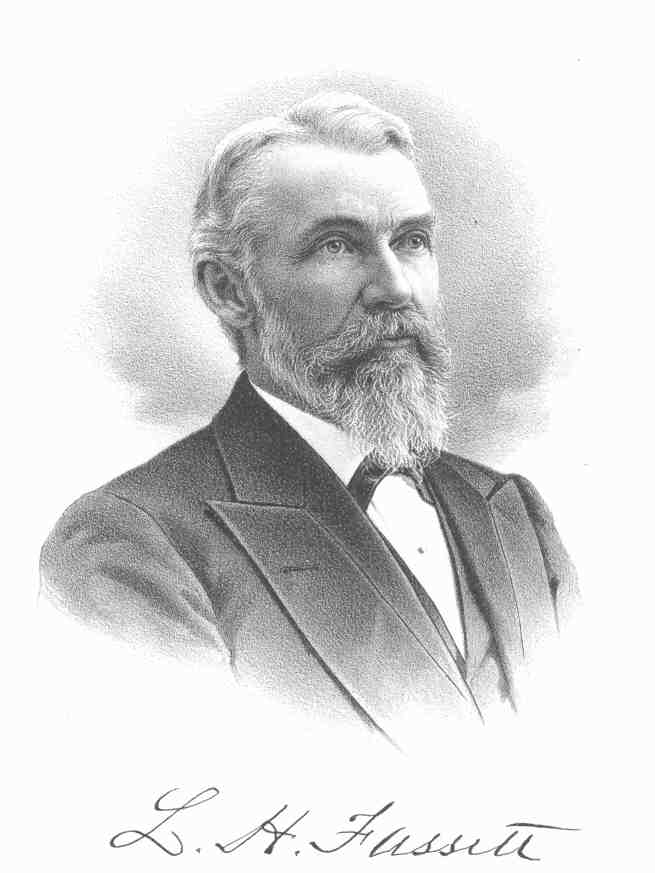Husband Col. Lewis Henry Fassett 1 2 3

AKA: L. H. Fossit 4
Born: 10 Dec 1832 - Bradford Co, PA 4 5
Christened:
Died: 3 Nov 1911 - Franklin, Venango Co, PA 2
Buried: - Franklin Cemetery, Franklin, Venango Co, PA
Father: Philo Fassett (1787-1868) 2 6
Mother: Miriam Rugg Wheeler (1791-1864) 2 4
Marriage: 27 May 1880 7
Wife Leah Jane Dale 2 3 8
Born:
Christened:
Died:
Buried:
Father: Samuel Futhey Dale (1816-1876) 9 10 11 12
Mother: Harriet Eliza McClelland (1816-1901) 10 12 13 14
Children
1 F Eliza Dale Fassett 2 3
Born:
Christened:
Died:
Buried:
Spouse: Charles Edward Wilcox Salter (1874- ) 15
Marr: 10 Sep 1914 - Franklin, Venango Co, PA 3
General Notes: Husband - Col. Lewis Henry Fassett
He was educated at Elmira, New York, and spent his early life on the homestead farm, which he purchased at the age of twenty-one, and continued farming and lumbering until the breaking out of the Rebellion. When Lincoln made his call for "three hundred thousand more" it aroused his patriotism, and he "left the plow in the furrow" and enlisted in Company G, Sixty-Fourth New York Volunteers, September 17, 1861, at Elmira, NY. Ten days afterward he was elected first lieutenant of his company, and at the battle of Fredericksburg December 13, 1862, he was promoted to the captaincy thereof. Immediately after the advance on Petersburg, in 1864, he was promoted to major, which was very soon followed by a commission as brevet lieutenant colonel for gallantry and meritorious conduct. He served as colonel of his regiment until the end of his term of service, and was mustered out with the remnant of his command September 8, 1864. His regiment was attached to the Second army corps, Army of the Potomac, and he participated in forty-two regular engagements, commencing at Yorktown, May 5, 1862, and ending with the battle of Ream's Station, August 25, 1864. He served in the following battles in 1862: Yorktown, May 5th; Williamsburg, May 6th; Fair Oaks, June 1st; Mechanicsville, June 26th; Gaines' Mills, June 27th; Peach Orchard, June 28th; Savage Station, June 29th; Glendale, June 30th; Malvern Hill, July 1st; South Mountain, September 14th; Antietam, September 16th and 17th; Snicker's Gap, November 2nd, and Fredericksburg, December 12th, 13th, and 14th. In 1863: Chancellorsville, May 2nd, 3rd, and 4th; Gettysburg, July 1st, 2nd, and 3rd; Funkstown, July 12th, and Falling Waters, July 14th. In 1864: The battles of the Wilderness, May 5th, 6th, and 7th; Poe River, May 10th; Spottsylvania, May 12th, 13th, and 14th; North Anna, May 23rd, 24th, and 25th; Tolopotomoy, May 28th, 29th, and 30th; Cold Harbor, June 1st to 12th; Petersburg, June 17th, 18th, and 19th; Weldon Railroad, June 22nd and 23rd; Deep Bottom, July 27th and 28th; Strawberry Plains, August 14th, 15th, and 16th; Six Mile House, August 19th and 20th, and Ream's Station, August 25th. He was captured at the last named battle and held prisoner for a few moments, but in the general rush and confusion he escaped to the Union lines.
Colonel Fassett passed through the campaign without serious injury, but he had some very "close calls." He was a temperate and brave soldier, and used neither whiskey, tobacco, nor profanity. He was respected by his men and received many complimentary appointments of trust and responsibility. On the 20th of January, 1862, he was appointed by General O. O. Howard to take command of a recruiting party and report for duty at Albany, NY. Completing this service he returned to his regiment April 28th in time to take part in the battle of Yorktown. In July, 1863, soon after the heavy losses at Gettysburg, he was detailed in command of a detachment to report to Elmira, New York, to take charge of drafted men that were assigned to the Second army corps. His regiment was always attached to the Second corps, commanded by General Winfield Scott Hancock. Lieutenant Colonel William F. Fox, in his popular work on "Regimental Losses in the American Civil War of 1861-1865" says of this corps: "The Second army corps was prominent by reason of its longer and continuous service, larger organization, hardest fighting, and greatest number of casualties. Within its ranks was the regiment which sustained the largest percentage of loss in any one action; also the regiment which sustained the greatest numerical loss in any one action; also the regiment which sustained the greatest numerical loss during its term of service; while of the one hundred regiments of the Union army which lost the most men in battle, thirty-five of them belonged to the Second corps." A remarkable feature with regard to losses in Colonel Fassett's regiment is that the records on file at Washington show that it lost more men in killed and wounded than its original number when it marched to the front in 1861. It would thus have been wiped out of existence had it not been replenished from time to time with recruits and drafted men.
At the close of the war Colonel Fassett located at Elmira, New York, and engaged in the wholesale grocery trade. In 1870 he removed to Franklin, Pennsylvania, and commenced the production of oil, and in 1873 established the Crescent Oil Works. He produced and manufactured the celebrated natural Franklin lubricating oil.
Colonel Fassett was an ardent Republican, was one of the charter members of Mays Post, G. A. R., and was a member of the Presbyterian church. [HVC 1890, 795]